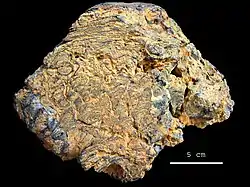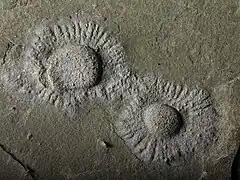Paleoproterozoic
The Paleoproterozoic Era[4] (also spelled Palaeoproterozoic), spanning the time period from 2,500 to 1,600 million years ago (2.5–1.6 Ga), is the first of the three sub-divisions (eras) of the Proterozoic Eon. The Paleoproterozoic is also the longest era of the Earth's geological history. It was during this era that the continents first stabilized.
| Paleoproterozoic | ||||||
|---|---|---|---|---|---|---|
 Paleoproterozoic stromatolites | ||||||
| Chronology | ||||||
| ||||||
| Proposed redefinition(s) | 2420–541 Ma Gradstein et al., 2012 | |||||
| Proposed subdivisions | Oxygenian Period, 2420–2250 Ma Gradstein et al., 2012 | |||||
| Etymology | ||||||
| Name formality | Formal | |||||
| Alternate spelling(s) | Palaeoproterozoic | |||||
| Usage information | ||||||
| Celestial body | Earth | |||||
| Regional usage | Global (ICS) | |||||
| Time scale(s) used | ICS Time Scale | |||||
| Definition | ||||||
| Chronological unit | Era | |||||
| Stratigraphic unit | Erathem | |||||
| Time span formality | Formal | |||||
| Lower boundary definition | Defined Chronometrically | |||||
| Lower GSSA ratified | 1991[1] | |||||
| Upper boundary definition | Defined Chronometrically | |||||
| Upper GSSA ratified | 1991[1] | |||||
Paleontological evidence suggests that the Earth's rotational rate ~1.8 billion years ago equated to 20-hour days, implying a total of ~450 days per year.[5]
Atmosphere
At the beginning of this era, almost all existing lifeforms were anaerobic organisms whose metabolism was based on a form of cellular respiration that did not require oxygen. Free oxygen in large amounts is toxic to most anaerobic organisms. Consequently, most died when the atmospheric free oxygen levels soared in an extinction event called the Great Oxidation Event during parts of the Siderian and Rhyacian periods. This brought atmospheric oxygen up to 10% of its current level.[6] The only creatures that survived were either resistant to the oxidizing and poisonous effects of oxygen or sequestered in oxygen-free environments. The sudden increase of atmospheric free oxygen and the ensuing extinction of the vulnerable lifeforms is widely considered one of the first and most significant mass extinctions on Earth.[7][8]
Emergence of Eukarya

Many crown node eukaryotes (from which the modern-day eukaryotic lineages would have arisen) have been approximately dated to around the time of the Paleoproterozoic Era.[9][10][11] While there is some debate as to the exact time at which eukaryotes evolved,[12][13] current understanding places it somewhere in this era.[14][15][16] Statherian fossils from the Changcheng Group of North China provide evidence that eukaryotic life was already diverse during the late Palaeoproterozoic.[17]
Geological events
During this era, the earliest global-scale continent-continent collision belts developed. The associated continent and mountain building events are represented by the 2.1–2.0 Ga Trans-Amazonian and Eburnean orogens in South America and West Africa; the ~2.0 Ga Limpopo Belt in southern Africa; the 1.9–1.8 Ga Trans-Hudson, Penokean, Taltson–Thelon, Wopmay, Ungava and Torngat orogens in North America, the 1.9–1.8 Ga Nagssugtoqidian Orogen in Greenland; the 1.9–1.8 Ga Kola–Karelia, Svecofennian, Volhyn-Central Russian, and Pachelma orogens in Baltica (Eastern Europe); the 1.9–1.8 Ga Akitkan Orogen in Siberia; the ~1.95 Ga Khondalite Belt; the ~1.85 Ga Trans-North China Orogen in North China; and the 1.8-1.6 Ga Yavapai and Mazatzal orogenies in southern North America.
That pattern of collision belts supports the formation of a Proterozoic supercontinent named Columbia or Nuna.[18][19] That continental collisions suddenly led to mountain building at large scale is interpreted as having resulted from increased biomass and carbon burial during and after the Great Oxidation Event: Subducted carbonaceous sediments are hypothesized to have lubricated compressive deformation and led to crustal thickening.[20]
Felsic volcanism in what is now northern Sweden led to the formation of the Kiruna and Arvidsjaur porphyries.[21]
The lithospheric mantle of Patagonia's oldest blocks formed.[22]
See also
- Boring Billion – Earth history, 1.8 to 0.8 billion years ago
- Suavjärvi impact structure – Lake and claimed impact structure in Karelia, northwest Russia
- Francevillian biota – Possible Palaeoproterozoic multicellular fossils from Gabon
- Vredefort impact structure – Largest verified impact structure on Earth, about 2 billion years old
- Sudbury Basin – Third largest verified astrobleme on earth, remains of an Paleoproterozoic Era impact
- Neoarchean – Fourth era of the Archean Eon, which immediately preceded the Paleoproterozoic
References
- Plumb, K. A. (June 1, 1991). "New Precambrian time scale". Episodes. 14 (2): 139–140. doi:10.18814/epiiugs/1991/v14i2/005.
- "palaeo-". Lexico UK English Dictionary. Oxford University Press. Archived from the original on 2020-06-18. "Proterozoic". Lexico UK English Dictionary. Oxford University Press. Archived from the original on 2020-06-17.
- "Proterozoic". Merriam-Webster.com Dictionary.
- There are several ways of pronouncing Paleoproterozoic, including IPA: /ˌpælioʊˌproʊtərəˈzoʊɪk, ˌpeɪ-, -liə-, -ˌprɒt-, -əroʊ-, -trə-, -troʊ-/ PAL-ee-oh-PROH-tər-ə-ZOH-ik, PAY-, -PROT-, -ər-oh-, -trə-, -troh-.[2][3]
- Pannella, Giorgio (1972). "Paleontological evidence on the Earth's rotational history since early precambrian". Astrophysics and Space Science. 16 (2): 212. Bibcode:1972Ap&SS..16..212P. doi:10.1007/BF00642735. S2CID 122908383.
- Ossa Ossa, Frantz; Spangenberg, Jorge E.; Bekker, Andrey; König, Stephan; Stüeken, Eva E.; Hofmann, Axel; Poulton, Simon W.; Yierpan, Aierken; Varas-Reus, Maria I.; Eickmann, Benjamin; Andersen, Morten B.; Schoenberg, Ronny (15 September 2022). "Moderate levels of oxygenation during the late stage of Earth's Great Oxidation Event". Earth and Planetary Science Letters. 594: 117716. doi:10.1016/j.epsl.2022.117716.
- Hodgskiss, Malcolm S. W.; Crockford, Peter W.; Peng, Yongbo; Wing, Boswell A.; Horner, Tristan J. (27 August 2019). "A productivity collapse to end Earth's Great Oxidation". Proceedings of the National Academy of Sciences of the United States of America. 116 (35): 17207–17212. Bibcode:2019PNAS..11617207H. doi:10.1073/pnas.1900325116. PMC 6717284. PMID 31405980.
- Margulis, Lynn; Sagan, Dorion (1997-05-29). Microcosmos: Four Billion Years of Microbial Evolution. University of California Press. ISBN 9780520210646.
- Mänd, Kaarel; Planavsky, Noah J.; Porter, Susannah M.; Robbins, Leslie J.; Wang, Changle; Kraitsmann, Timmu; Paiste, Kärt; Paiste, Päärn; Romashkin, Alexander E.; Deines, Yulia E.; Kirsimäe, Kalle; Lepland, Aivo; Konhauser, Kurt O. (15 April 2022). "Chromium evidence for protracted oxygenation during the Paleoproterozoic". Earth and Planetary Science Letters. 584: 117501. doi:10.1016/j.epsl.2022.117501. hdl:10037/24808. Retrieved 15 December 2022.
- Hedges, S Blair; Chen, Hsiong; Kumar, Sudhir; Wang, Daniel YC; Thompson, Amanda S; Watanabe, Hidemi (2001-09-12). "A genomic timescale for the origin of eukaryotes". BMC Evolutionary Biology. 1: 4. doi:10.1186/1471-2148-1-4. ISSN 1471-2148. PMC 56995. PMID 11580860.
- Hedges, S Blair; Blair, Jaime E; Venturi, Maria L; Shoe, Jason L (2004-01-28). "A molecular timescale of eukaryote evolution and the rise of complex multicellular life". BMC Evolutionary Biology. 4: 2. doi:10.1186/1471-2148-4-2. ISSN 1471-2148. PMC 341452. PMID 15005799.
- Rodríguez-Trelles, Francisco; Tarrío, Rosa; Ayala, Francisco J. (2002-06-11). "A methodological bias toward overestimation of molecular evolutionary time scales". Proceedings of the National Academy of Sciences of the United States of America. 99 (12): 8112–8115. Bibcode:2002PNAS...99.8112R. doi:10.1073/pnas.122231299. ISSN 0027-8424. PMC 123029. PMID 12060757.
- Stechmann, Alexandra; Cavalier-Smith, Thomas (2002-07-05). "Rooting the eukaryote tree by using a derived gene fusion". Science. 297 (5578): 89–91. Bibcode:2002Sci...297...89S. doi:10.1126/science.1071196. ISSN 1095-9203. PMID 12098695. S2CID 21064445.
- Ayala, Francisco José; Rzhetsky, Andrey; Ayala, Francisco J. (1998-01-20). "Origin of the metazoan phyla: Molecular clocks confirm paleontological estimates". Proceedings of the National Academy of Sciences of the United States of America. 95 (2): 606–611. Bibcode:1998PNAS...95..606J. doi:10.1073/pnas.95.2.606. ISSN 0027-8424. PMC 18467. PMID 9435239.
- Wang, D Y; Kumar, S; Hedges, S B (1999-01-22). "Divergence time estimates for the early history of animal phyla and the origin of plants, animals and fungi". Proceedings of the Royal Society B: Biological Sciences. 266 (1415): 163–171. doi:10.1098/rspb.1999.0617. PMC 1689654. PMID 10097391.
- Javaux, Emmanuelle J.; Lepot, Kevin (January 2018). "The Paleoproterozoic fossil record: Implications for the evolution of the biosphere during Earth's middle-age". Earth-Science Reviews. 176: 68–86. doi:10.1016/j.earscirev.2017.10.001.
- Miao, Lanyun; Moczydłowska, Małgorzata; Zhu, Shixing; Zhu, Maoyan (February 2019). "New record of organic-walled, morphologically distinct microfossils from the late Paleoproterozoic Changcheng Group in the Yanshan Range, North China". Precambrian Research. 321: 172–198. doi:10.1016/j.precamres.2018.11.019. S2CID 134362289. Retrieved 29 December 2022.
- Zhao, Guochun; Cawood, Peter A; Wilde, Simon A; Sun, Min (2002). "Review of global 2.1–1.8 Ga orogens: implications for a pre-Rodinia supercontinent". Earth-Science Reviews. 59 (1–4): 125–162. Bibcode:2002ESRv...59..125Z. doi:10.1016/S0012-8252(02)00073-9.
- Zhao, Guochun; Sun, M.; Wilde, Simon A.; Li, S.Z. (2004). "A Paleo-Mesoproterozoic supercontinent: assembly, growth and breakup". Earth-Science Reviews. 67 (1–2): 91–123. Bibcode:2004ESRv...67...91Z. doi:10.1016/j.earscirev.2004.02.003.
- John Parnell, Connor Brolly: Increased biomass and carbon burial 2 billion years ago triggered mountain building. Nature Communications Earth & Environment, 2021, doi:10.1038/s43247-021-00313-5 (Open Access).
- Lundqvist, Thomas (2009). Porfyr i Sverige: En geologisk översikt (in Swedish). pp. 24–27. ISBN 978-91-7158-960-6.
- Schilling, Manuel Enrique; Carlson, Richard Walter; Tassara, Andrés; Conceição, Rommulo Viveira; Berotto, Gustavo Walter; Vásquez, Manuel; Muñoz, Daniel; Jalowitzki, Tiago; Gervasoni, Fernanda; Morata, Diego (2017). "The origin of Patagonia revealed by Re-Os systematics of mantle xenoliths". Precambrian Research. 294: 15–32. Bibcode:2017PreR..294...15S. doi:10.1016/j.precamres.2017.03.008.
External links
- EssayWeb Paleoproterozoic Era
- First breath: Earth's billion-year struggle for oxygen New Scientist, #2746, 5 February 2010 by Nick Lane. Posits an earlier much longer snowball period, c2.4 - c2.0 Gya, triggered by the Great Oxygenation Event.
- The information on eukaryotic lineage diversification was gathered from a New York Times opinion blog by Olivia Judson. See the text here: .
- Paleoproterozoic (chronostratigraphy scale)